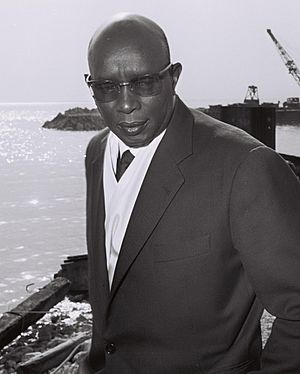Mwambutsa IV of Burundi facts for kids
Quick facts for kids Mwambutsa IV |
|
|---|---|

Mwambutsa on a visit to Israel in 1962
|
|
| King of Burundi | |
| Reign | 16 December 1915 – 8 July 1966 |
| Coronation | 16 December 1915 |
| Predecessor | Mutaga IV Mbikije |
| Successor | Ntare V Ndizeye |
| Prime ministers |
See list
Joseph Cimpaye
Louis Rwagasore André Muhirwa Pierre Ngendandumwe Albin Nyamoya Pié Masumbuko (Acting) Joseph Bamina Léopold Biha |
| Born | Prince Bangiricenge of Burundi 6 May 1912 Nyabiyogi, Burundi, German East Africa |
| Died | 26 March 1977 (aged 64) Geneva, Switzerland |
| Burial | Meyrin, Switzerland |
| Spouse | Thérèse Kanyonga Baramparaye Ruhasha |
| Issue |
|
| House | Ntwero |
| Father | Mutaga IV Mbikije |
| Mother | Princess Ngenzahago |
| Religion | Catholicism |
Mwambutsa IV Bangiricenge (born May 6, 1912 – died March 26, 1977) was a king of Burundi. He was the second-to-last king, ruling from 1915 to 1966. He became king after his father, Mutaga IV Mbikije, passed away. Mwambutsa's rule happened mostly when Burundi was under Belgian colonial rule (1916–1962). The Belgians allowed the kings of both Rwanda and Burundi to keep their titles, but they still controlled the countries.
Contents
Early Life and Becoming King
Mwambutsa IV was born Prince Bangiricenge around 1912 in Nyabiyogi, a part of Burundi. He was one of two sons of King Mutaga IV. Like other Burundian kings, he belonged to the Ganwa ethnic group.
He became king on December 16, 1915, when he was just a baby. He took the name Mwambutsa. Because he was so young, a group of family members, including his mother, ruled for him. This is called a regency.
At that time, Burundi was part of German East Africa. But in 1916, during World War I, Belgium took control of the area. In 1925, the Belgians helped set up a formal regency council to rule for the young king.
Mwambutsa received a traditional Burundian education until he was about 13. In 1925, the Belgians opened a school in Muramvya for him to attend. Later, a Roman Catholic mission tried to teach him more and hoped he would become Catholic, but he never did.
Ruling Under Colonial Power
Mwambutsa officially became the ruler on his own on August 28, 1929. This was when the regency council decided he was old enough to rule. On December 24, 1930, he married Thérèse Kanyonga. She was from the Tutsi ethnic group and was Catholic.
Mwambutsa tried to stay out of political arguments between different groups. On February 8, 1960, he said, "I don't belong to any political party." He wanted all groups to work for the good of Burundi. In June 1962, just before Burundi became independent, he traveled around the country. He gave speeches asking people to work hard and follow the law.
After Independence and Exile
Burundi became an independent country, the Kingdom of Burundi, on July 1, 1962. Mwambutsa was there for the celebrations in Bujumbura. He gave a speech asking Burundians and foreign experts to "work together" to make Burundi a "peaceful, hard-working, prosperous, and perfectly happy country."
On December 15, Mwambutsa was given an award by the Pope. He met with the Pope at Vatican City the next day.
After Burundi became independent, Mwambutsa IV became the head of the country. He had a lot of political power. He tried to keep peace between the Hutu and Tutsi ethnic groups. He did this by choosing his prime ministers from each group, one after the other.
In October 1965, some Hutu officers tried to take over the government. This is called a coup d'état. Even though they failed, Mwambutsa left Burundi and went to live in the Republic of the Congo. He later moved to Switzerland.
In March 1966, he asked his only living son, Charles Ndizeye, to take over his duties in Burundi. Mwambutsa was still in exile when he was officially removed from power in a second coup on July 8, 1966. His son, Ntare V, then became king.
However, the monarchy was completely ended in a third coup in November 1966. The leader of this coup, Michel Micombero, became the president and ruler of the country. Mwambutsa lived the rest of his life in Switzerland and passed away in 1977.
Images for kids
-
Mwambutsa IV and David Ben-Gurion in 1962
Exhumation
In 2012, Mwambutsa's body was dug up from where it was buried in Switzerland. The plan was to bring it back to Burundi for a state funeral. However, after a legal disagreement, his body was re-buried in Switzerland in 2016, as his family wanted.
See also
 In Spanish: Mwambutsa IV para niños
In Spanish: Mwambutsa IV para niños




